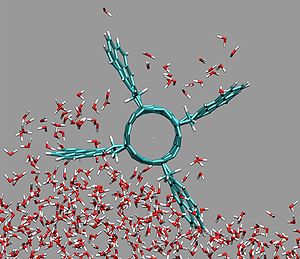- Molecular propeller
-
Molecular propeller is a molecule that can propel fluids when rotated, due to its special shape that is designed in analogy to macroscopic propellers [1] [2] : it has several molecular-scale blades attached at a certain pitch angle around the circumference of a shaft, aligned along the rotational axis.
The molecular propellers designed in the group of Prof. Petr Král from the University of Illinois at Chicago have their blades formed by planar aromatic molecules and the shaft is a carbon nanotube [3]. Molecular dynamics simulations show that these propellers can serve as efficient pumps in the bulk and at the surfaces of liquids. Their pumping efficiency depends on the chemistry of the interface between the blades and the liquid. For example, if the blades are hydrophobic, water molecules do not bind to them, due to their little bond polarity, and the propellers can pump them well. If the blades are hydrophilic, water molecules form hydrogen bonds with the atoms in the polar blades. This can largely block the flow of other water molecules around the blades and significantly slow down their pumping.
Contents
Driving
Molecular propellers can be rotated by molecular motors that can be driven by chemical, biological, optical and electrical means [4] [5] [6], or various ratchet-like mechanisms [7]. Nature realizes most biological activities with a large number of highly sophisticated molecular motors, such as myosin, kinesin, and ATP synthase [8]. For example, rotary molecular motors attached to protein-based tails called flagella can propel bacteria.
Applications
In a similar way, the assembly of a molecular propeller and a molecular motor can form a nanoscale machine that can pump fluids or perform locomotion [9]. Future applications of these nanosystems range from novel analytical tools in physics and chemistry, drug delivery and gene therapy in biology and medicine, advanced nanofluidic lab-on-a-chip techniques, to tiny robots performing various activities at the nanoscale or microscale.
See also
References
- ^ J. Vacek and J. Michl, A molecular "Tinkertoy" construction kit: Computer simulation of molecular propellers, New J. Chem. 21, 1259 1997.
- ^ C. D. Simpson, G. Mattersteig, K. Martin, L. Gherghel, R. E. Bauer, H. J. Rader and K. Mullen, Nanosized molecular propellers by cyclodehydrogenation of polyphenylene dendrimers, J. Am. Chem. Soc. 126, 3139 2004. Abstract
- ^ B. Wang and P. Král, Chemically Tunable Nanoscale Propellers of Liquids, Phys. Rev. Let. 98, 266102 2007. Abstract
- ^ T. R. Kelly, H. De Silva and R. A. Silva, Unidirectional rotary motion in a molecular system, Nature 401, 150 1999. Abstract
- ^ N. Koumura, R. W. J. Zijlstra, R. A. van Delden, N. Harada and B. L. Feringa, Light-driven monodirectional molecular rotor, Nature 401, 152 1999. Abstract
- ^ C. Bustamante, Y. R. Chemla, N. R. Forde and D. Izhaky, Mechanical processes in biology, Annual Review of Biochemistry, 73, 705 2004. Abstract
- ^ R. D. Astumian, Thermodynamics and kinetics of a Brownian motor, Science 276, 917 1997. Abstract
- ^ S. P. Tsunoda, R. Aggeler, M. Yoshida, and R. A. Capaldi, Rotation of the c subunit oligomer in fully functional F1Fo ATP synthase, Proc. Natl. Acad. Sci. USA, 98, 898 2001. Abstract
- ^ R. K. Soong, G. D. Bachand, H. P. Neves, A. G. Olkhovets, H. G. Craighead and C. D. Montemagno, Powering an inorganic nanodevice with a biomolecular motor, Science 290, 1555 2000. Abstract
External links
Categories:- Molecular machines
Wikimedia Foundation. 2010.

